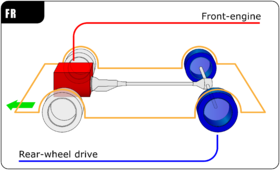| Revision as of 21:50, 3 January 2024 editJip Orlando (talk | contribs)Extended confirmed users, Pending changes reviewers, Rollbackers9,700 edits not for every vehicle← Previous edit |
Revision as of 00:56, 1 April 2024 edit undoTooManyFingers (talk | contribs)Extended confirmed users7,081 edits →Front mid-engine, rear-wheel-drive layout: Added the word "half", because "in the front" (when used by itself) very often means "frontmost".Tags: Mobile edit Mobile web edit Advanced mobile editNext edit → |
| Line 12: |
Line 12: |
|
] |
|
] |
|
|
|
|
|
A '''front mid-engine, rear-wheel-drive layout''' '''(FMR)''' places the engine in the front of the vehicle but ''behind'' the front axle, which likewise drives the rear wheels via a driveshaft. Shifting the engine's ] rearward aids in front/rear ] and reduces the ], both of which improve a vehicle's ].{{citation needed span|While the mechanical layout of an FMR is substantially the same as an FR car, the classification of some models of the same vehicle may vary as either FR or FMR depending on the length of the engine (e.g. 4-cylinder vs. 6-cylinder) and its center of mass in relation to the front axle.|reason=It is a boldface potentially contentious claim without any support.|date=January 2023}} |
|
A '''front mid-engine, rear-wheel-drive layout''' '''(FMR)''' places the engine in the front half of the vehicle but ''behind'' the front axle, which likewise drives the rear wheels via a driveshaft. Shifting the engine's ] rearward aids in front/rear ] and reduces the ], both of which improve a vehicle's ].{{citation needed span|While the mechanical layout of an FMR is substantially the same as an FR car, the classification of some models of the same vehicle may vary as either FR or FMR depending on the length of the engine (e.g. 4-cylinder vs. 6-cylinder) and its center of mass in relation to the front axle.|reason=It is a boldface potentially contentious claim without any support.|date=January 2023}} |
|
|
|
|
|
FMR cars are often characterized by a long hood and front wheels that are pushed forward to the corners of the vehicle, close to the front bumper. ]-style ]s often have FMR layouts, as a rear engine does not leave much space for rear seats. |
|
FMR cars are often characterized by a long hood and front wheels that are pushed forward to the corners of the vehicle, close to the front bumper. ]-style ]s often have FMR layouts, as a rear engine does not leave much space for rear seats. |
FMR cars are often characterized by a long hood and front wheels that are pushed forward to the corners of the vehicle, close to the front bumper. 2+2-style grand tourers often have FMR layouts, as a rear engine does not leave much space for rear seats.


 The 390 cd V8 engine in a FR 1968 AMC AMX functionally straddles its front axle, with the centerline of the shock towers basically bisecting the center of the air cleaner
The 390 cd V8 engine in a FR 1968 AMC AMX functionally straddles its front axle, with the centerline of the shock towers basically bisecting the center of the air cleaner
 The straight-6 DOHC XK engine clearly sits behind the front axle of an FMR Jaguar E-Type
The straight-6 DOHC XK engine clearly sits behind the front axle of an FMR Jaguar E-Type
All Chevrolet Corvette from the second generation (model year 1963) through the seventh generation (model year 2019) are FMR. Only ancillary aspects of this Chevrolet Corvette ZR-1's engine may lie above the front axle.
An FMR Dodge Viper showing its 8.4l V10 positioned behind the car’s front axle